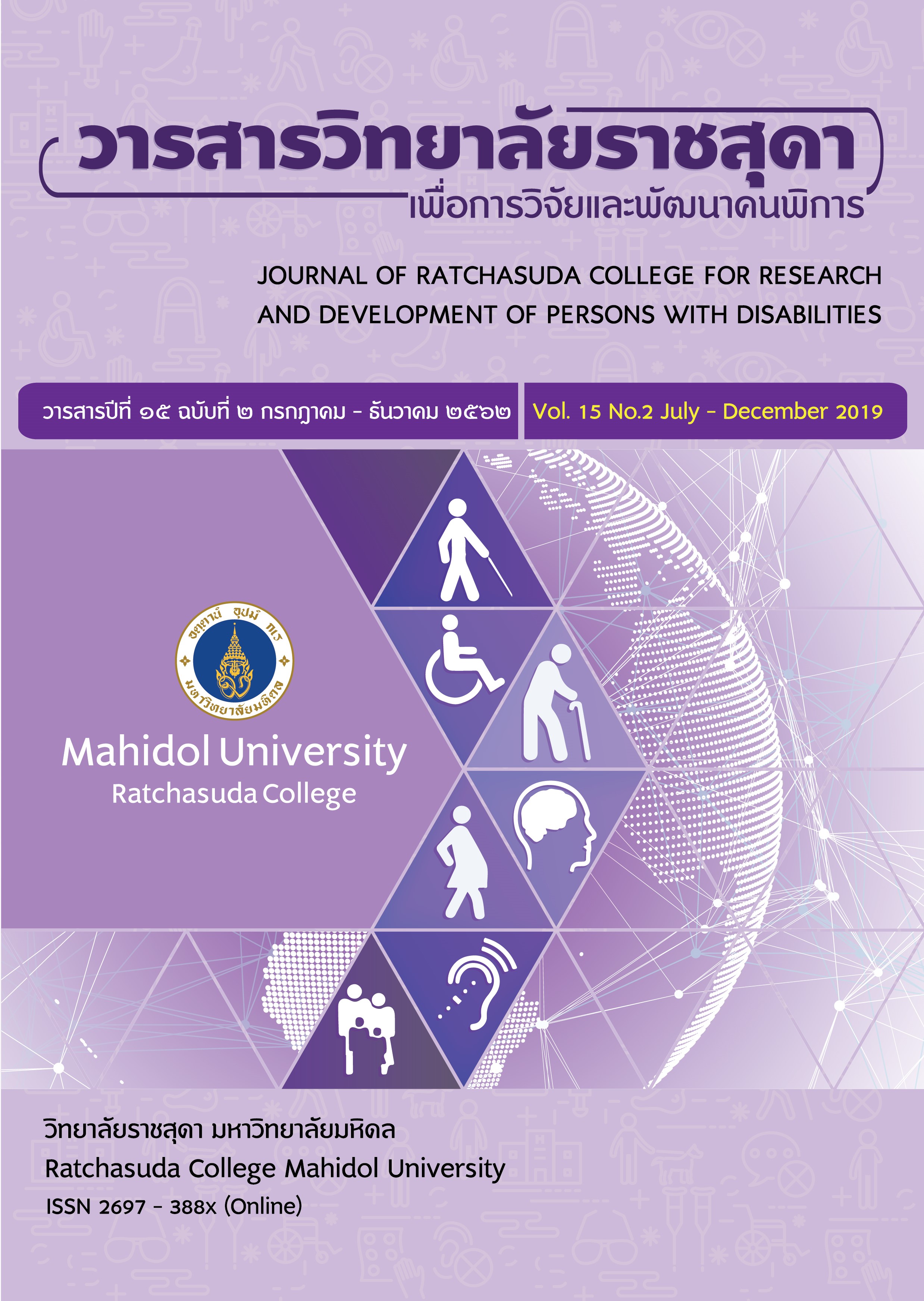The Current States, Strengths, Weaknesses, Opportunities, and Threats of Learning and Teaching of Roi – Et School for the Deaf
Keywords:
สภาพปัจจุบัน, จุดแข็ง จุดอ่อน โอกาสและอุปสรรค, การจัดการเรียนการสอน, โรงเรียนโสตศึกษาAbstract
This research aims to 1) study the current states of learning and teaching of Roi-Et school for the deaf and 2) analysis of the strengths, weaknesses, opportunities, and threats of learning and teaching by the qualitative research method. Six teachers were involved as participants in This research aims to 1) study the current states of learning and teaching of Roi-Et school for the deaf and 2) analysis of the strengths, weaknesses, opportunities, and threats of learning and teaching by the qualitative research method. Six teachers were involved as participants in this research as the researcher selected participants with purposive sampling and the data were collected by using focus group discussion and in-depth interviews. Tools are focusing group form and the in-depth interview form, as well as the data were analyzed by the ATLAS. ti program. The research findings are as follows:
1) For the state of teaching and learning, it was found that regular instructional models 1) For the state of teaching and learning, it was found that regular instructional models for teaching and learning on the core curriculum of the Ministry of Education and the Waldorf educational, teachers use to teach by using sign language, holistic approach, pictures, role-play and video. The school contributed financial budgets for producing the instructional media to teachers. 2) For the strengths, the school has planned to construct the classrooms so that teachers could create the school and subject curriculum. The school also provides the training and testing sign language to teachers and they can apply research methodologies for learning and teaching problems. Furthermore, teachers use integrated teaching and also facilitated instructional media. For the weaknesses, it was found that budgets for producing the instructional media were insufficient and most of the teachers were not experts in research methodology and technology use. For the opportunities, it was found that Thailand supported education to students with hearing impairments and the gove rnment organization gave some educational facilities and communities participated in the education administration. For the threats, it was found that the educational policy was difficult to apply in real situations, the core curriculum did not correspond to students learning competencies, and some sign language vocabularies for academics were not even in all subjects.
References
Chaiwatthanakunwanit, S. (2013). Development of An Alternative Educational Provision model to Improve Quality of Life of Children with Special Needs : A Case Study of Hearing Impaired Children. (Doctoral dissertation). Chulalongkorn University, Bangkok,Thailand.
Chandee, S. (2011). Learning framework for hearing impaired students. (Doctoral dissertation). King Mongkut’s University of Technology Thonburi, Bangkok, Thailand.
Chansongsaeng, W. (2006). The sound from the world is silent. Bangkok, Samlada Press.
Daocharoen, T. (2016). The Accessibility to Social welfare for Hearing Disability People in Amphoe Thamaka Changwat Kanchanaburi. (Master’s thesis). Silpakorn University, Bangkok, Thailand.
Ghulam Fatima, Abid Hussain Ch., & Misbah Malik. (2016). Instructional Practices used by Special Education Teachers in Classrooms of Young Children with Deafness. Bulletin of Education and Research, 38(1), 90-91.
Ministry of Education. (2015). Education Provision for Persons with Disabilities Act B.E.2008. Bangkok, Khurusapha Press.
Ministry of Education. (2009). National Education Act B.E. 1999 and Amendments (Second National Act. B.E.2002) and Thired National Education Act B.E.2010. Bangkok, Kurusapha Press.
Office of the Education Council. (2017). National Education Plan 2017-2036. Bangkok Press.
Parker, A.T. and Catherin Nelson. (2016). Toward a Compehensive System of Personal Development in Deafblind Education. American Annals of the Deaf, 164(4), 487-488.
Patjan, S. (2014). The Phenomenal Characteristics of Factors on the Sign Language Learning of Elementary Hearing Impaired Students. (Master’s thesis). Burapha University, Chonburi, Thailand.
Pizzo, L. (2013). Vocabulary instruction for the development of American sign language in Deaf children: An investigation into teacher knowledge and practice. (Doctoral dissertation). Boston College, Chestnut Hill Massachusetts, America.
Special Education Training package. (2010). The Project to upgrade the quality of teachers throughout the system according to the Thai Khem Khaeng Action Plan. Chulalongkorn University Press.
Sriorn, C. (2007). Reading ability and writing Thai language for students with hearing impaired, grade 6. (Master’s thesis). Mahidol University, Bangkok, Thailand.
Thamsaeng, M. (2011). Language teaching methods for deaf children. Setsatian School for the Deaf under the Royal Patronage of his Royal highness Crown Prince Maha Vajiralongkorn Press.
The National Deaf Children’s Society. (2004). Deaf friendly teaching. London: The National Deaf Children’s Society. ไม่ปรากฏสถานที่พิมพ์
Thirachit, W. (2002). Education for the Exceptional Children (3nd ed.). Chulalongkorn University Press.
Wanwichai, R. (2011). A Study of Thai Dance Teaching and Learning Environment for The Deaf Students in The Special Education School in Central Area. Srinakharinwirot University Press.
Downloads
Published
How to Cite
Issue
Section
License
บทความที่ได้รับการตีพิมพ์เป็นลิขสิทธิ์ของวารสารสถาบันราชสุดาเพื่อการวิจัยและพัฒนาคนพิการ





